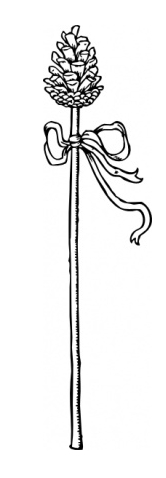Thyrsus

In Ancient Greece a thyrsus (/ˈθɜːrsəs/) or thyrsos (/ˈθɜːrsɒs/; Ancient Greek: θύρσος) was a wand or staff of giant fennel (Ferula communis) covered with ivy vines and leaves, sometimes wound with taeniae and topped with a pine cone, artichoke, fennel, or by a bunch of vine-leaves and grapes or ivy-leaves and berries, carried during Hellenic festivals and religious ceremonies.[1][2] The thyrsus is typically associated with the Greek god Dionysus, and represents a symbol of prosperity, fertility, and hedonism similarly to Dionysus.[3]
Religious and ceremonial use[edit]
In Greek religion, the staff was carried by the devotees of Dionysus. Euripides wrote that honey dripped from the thyrsos staves that the Bacchic maenads carried.[4] The thyrsus was a sacred instrument at religious rituals and fêtes.
The fabulous history of Bacchus relates that he converted the thyrsi carried by himself and his followers into dangerous weapons, by concealing an iron point in the head of leaves.[5] Hence his thyrsus is called "a spear enveloped in vine-leaves",[6] and its point was thought to incite to madness.[7]
Symbolism[edit]
The thyrsus, associated with the followers of Dionysus (the satyrs, thiasus, and maenads or Bacchantes), is a symbol of prosperity, fertility, hedonism, and pleasure/enjoyment in general.[8] The thyrsus was tossed in the Bacchic dance:
Pentheus: The thyrsus—in my right hand shall I hold it?
- Or thus am I more like a Bacchanal?
Dionysus: In thy right hand, and with thy right foot raise it.[9]
Sometimes the thyrsus was displayed in conjunction with a kantharos wine cup, another symbol of Dionysus, forming a male-and-female combination.[citation needed]
Literature[edit]

In the Iliad, Diomedes, one of the leading warriors of the Achaeans, mentions the thyrsus while speaking to Glaucus, one of the Lycian commanders in the Trojan army, about Lycurgus, the king of Scyros:
He it was that/drove the nursing women who were in charge/of frenzied Bacchus through the land of Nysa,/and they flung their thyrsi on the ground as/murderous Lycurgus beat them with his oxgoad.[10]
The thyrsus is explicitly attributed to Dionysus and his followers in Euripides's play, The Bacchae, a Greek tragedy describing the degradation of Thebes in vindication for the sullied name of Dionysus's mortal mother. The story surrounds the murder of the young king and indoctrination of all of the Theban women into Dionysus's cult, with the thyrsus serving as a badge of sorts for members.
To raise my Bacchic shout, and clothe all who respond/ In fawnskin habits, and put my thyrsus in their hands–/ The weapon wreathed with ivy-shoots... Euripides also writes, "There's a brute wildness in the fennel-wands—Reverence it well."[11]
Plato describes the hedonistic connotation of the thyrsus, and thereby Dionysus, in his philosophical Phaedo:
I conceive that the founders of the mysteries had a real meaning and were not mere triflers when they intimated in a figure long ago that he who passes unsanctified and uninitiated into the world below will live in a slough, but that he who arrives there after initiation and purification will dwell with the gods. For 'many', as they say in the mysteries, 'are the thyrsus bearers, but few are the mystics', – meaning, as I interpret the words, the true philosophers.[12]
In Part II of Johann Wolfgang von Goethe's Faust, Mephistopheles tries to catch a Lamia, only to find out that she is an illusion and instead holds a thyrsus. The play contains major themes of sin and hedonism, and makes connection to Dionysus through the thyrsus:
Well, then, a tall one I will catch... And now a thyrsus-pole I snatch! Only a pine-cone as its head.[13]
Robert Browning mentions the thyrsus in passing in The Bishop Orders His Tomb at St Praxed's Church, as the dying bishop confuses Christian piety with classical extravagance. Ovid talks about Bacchus carrying a thyrsus and his followers doing the same in his Metamorphoses Book III, which is a retelling of The Bacchae.
The bas-relief in bronze ye promised me,/Those Pans and nymphs ye wot of, and perchance/Some tripod, thyrsus, with a vase or so.[14]
Gallery[edit]
-
Roman relief showing a Maenad holding a thyrsus, 120–140 AD. Prado Museum, Madrid.
-
Bacchus Triumphant by John Reinhard Weguelin (1882)
-
A Bacchant holding a thyrsus: Malice by William-Adolphe Bouguereau (1899)
See also[edit]
Notes[edit]
- ^ "A Dictionary of Greek and Roman Antiquities (1890), THYRSUS". www.perseus.tufts.edu. Retrieved 2021-05-13.
- ^ Olszewski, Edward (2019). "Dionysus's Enigmatic Thyrsus". Proceedings of the American Philosophical Society. 163 (2): 153–173. ISSN 2326-9243. Dionysus's Enigmatic Thyrsus
- ^ Moulton, Carroll (1998). Ancient Greece and Rome: An Encyclopedia for Students. Vol. 2. New York, NY: Gale. pp. 7–9. ISBN 9780684805030.
- ^ Euripides, Bacchae, 711.
- ^ Diodorus. iii. 64, iv. 4; Macrobius. Sat. i. 19.
- ^ Ovid. Met. iii, 667
- ^ Hor. Carm. ii. 19. 8; Ovid. Amor. iii 1. 23, iii. 15. 17, Trist. iv. 1. 43.; Brunk, Anal. iii. 201; Orph. Hymn. xlv. 5, 1. 8.
- ^ Ioannis Kakridis, Ελληνική μυθολογία Εκδοτική Αθηνών 1987 (in Greek)
- ^ The Bacchae
- ^ Homer. "The Iliad". The Internet Classics Archive. VI. 132–137. Retrieved 2021-05-21.
- ^ Euripides (1972). The Bacchae and Other Plays. Translated by Vellacott, Philip (Rev. ed.). Harmondsworth, Eng.: Penguin Books. p. 192. ISBN 0-14-044044-5. OCLC 618722.
- ^ Plato. "Phaedo". The Internet Classics Archive. Retrieved 2021-05-21.
- ^ Goethe, Johann Wolfgang von. Faust. II. pp. 7775–7777.
- ^ Browning, Robert (2010). Robert Browning : selected poems. John Woolford, Daniel Karlin, Joseph Phelan. Harlow, England. pp. 56–58. ISBN 978-1-317-86491-2. OCLC 869374843.
{{cite book}}: CS1 maint: location missing publisher (link)
References[edit]
- Casadio, Giovanni; Johnston, Patricia A., Mystic Cults in Magna Graecia, University of Texas Press, 2009
- Ferdinand Joseph M. de Waele, The magic staff or rod in Græco-Italian antiquity, Drukkerij Erasmus, 1927
- Attribution
- This article incorporates text from a publication now in the public domain: Chisholm, Hugh, ed. (1911). "Thyrsus". Encyclopædia Britannica (11th ed.). Cambridge University Press.





